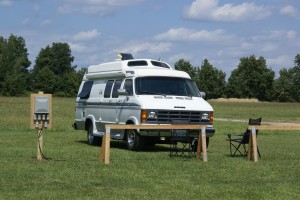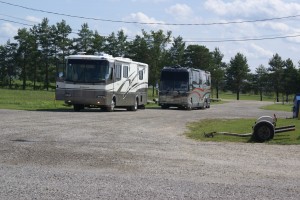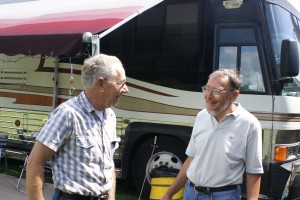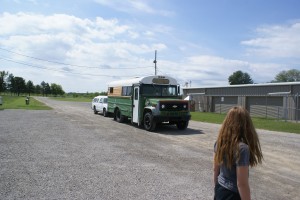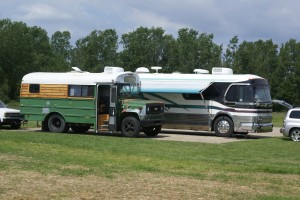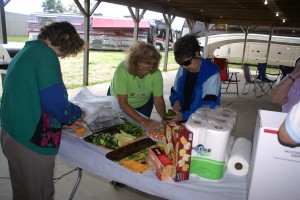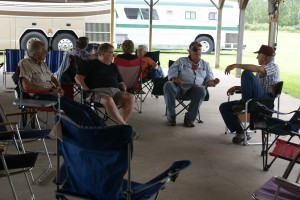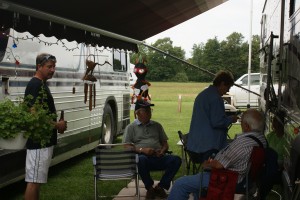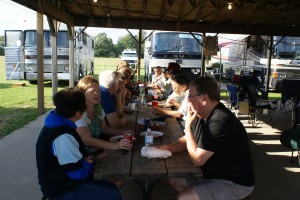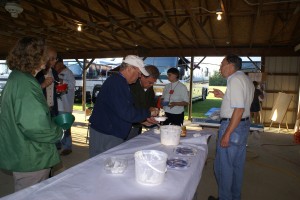The west is high, dramatic, stunning, stark, “gorgeous”, awe-inspiring, etc. It is also dry, hot, and barren in many places. Northern Minnesota and the Great Lakes Region in general, are beautiful, wooded, lush, green, cooler, and wetter. Not as good for the sinuses, but every place has its tradeoffs.
We fired up the generator at 0630 CDT to recharge the house batteries after using them all night to run the refrigerator, auxiliary air-compressor, and any small miscellaneous loads that were still on. I always like to bring them back up to full charge, and I have been determining that by waiting until the remote control/display shows that the charger has gone into “float” mode. Yesterday I figured out how to find the State Of Charge (SOC) meter, so I can now monitor directly the SOC of the battery bank.
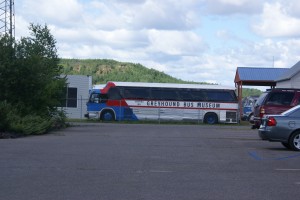
One of the outside buses…This must be the place!
Since Paul and Sharon offered to let us remain boondocked at the winery beyond the normal 1-day Harvest Host period we decided to drive the car to Hibbing, Minnesota to visit the Greyhound Bus Museum. I have wanted to visit this museum for a while but Hibbing, quite frankly, is not really on the way to anywhere. Besides the museum Hibbing is home base to the Hull Rust Mohoning iron ore mine, largest open-pit mine in the world. Up the road at Tower is an underground state park that houses an advanced physics laboratory where scientists are catching quarks.
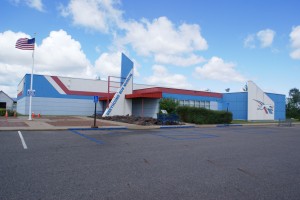
The Greyhound Bus Museum, Hibbing, MN.
The drive to Hibbing took 2 ½ hours. We spent two hours at the museum. I wasn’t sure what to expect, but we felt like we more than got our monies worth for the $5 adult admission. The museum is housed in a nice building with seven buses inside, a nice display of Greyhound artifacts, and lots of information about the origin and development of Greyhound, specifically, and bus transportation in the U.S. more generally. They have another six buses or so in a fenced lot behind the building. Most of the buses are open so you can go inside them. Here are some photos:
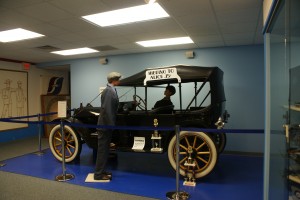
They started with a Hupmobile.
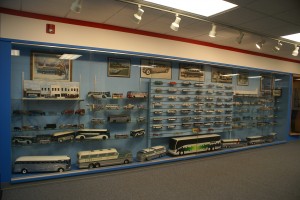
The museum has lots of model buses.
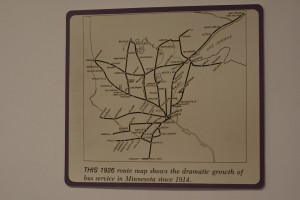
An early route map. It didn’t take long for the business to expand beyond Hibbing.
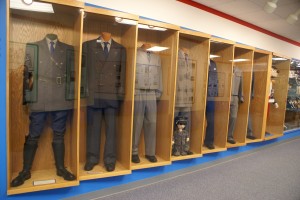
Uniforms for drivers came early and changed over the years.
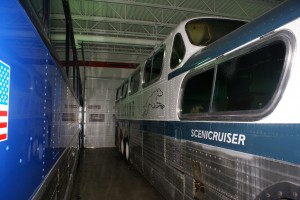
A 1956 PD4501 Scenic Cruiser. This is the iconic Greyhound Bus.
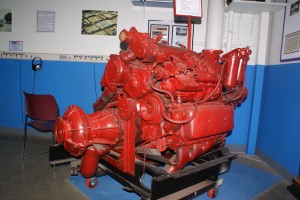
A DD 8V71 with numbered parts and a key.
The Detroit Diesel 8V71 series engines are pre-computer control machines and are still in operation today.
(See http://www.technomadia.com ; they have just had theirs rebuilt and have reported on the experience.)
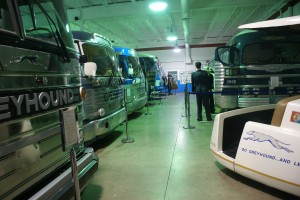
All of the inside buses lined up in a row, oldest to newest, far to near.
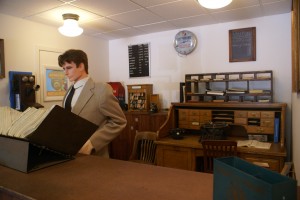
The lobby features an old time ticket office diorama.
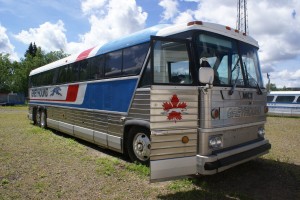
An MCI MC-12 that operated in Canada. I have never seen an MC-12 converted into an RV.
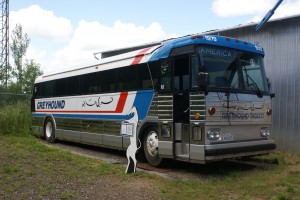
An MCI MC-5 specially made for use in Saudi Arabia. Note the double roof. Its purpose was to “shade” the main roof and dissipate heat to help keep the interior cooler.
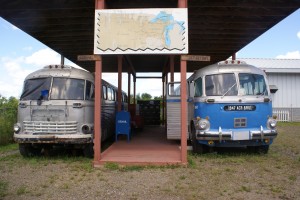
A pair of 1947 ACF Brill buses in a terminal mockup.
Greyhound used Yellow Coach buses in the 30’s and some ACF buses, but eventually used GMC buses (many different models) until GM stopped making them in the 1970’s. Somewhere along the line Greyhound started using MCI buses (MC-5, 7, 9, 12, and later 96- and 102- series) and over the years bought and used a lot of them. The MC-5 and MC-9 were particularly popular with bus converters. Commercial converters, like Custom Coach in Ohio, also did MC-9, as well 102- series, conversions.
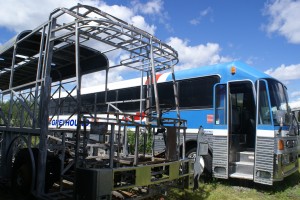
An Eagle Chassis and Complete Bus.
Greyhound also ran Eagle coaches. These became popular with some do-it-yourself motorhome converters because, unlike the GMC buses, the skin was non-structural and could more easily be removed and replaced. The chassis (skeleton in picture) was made of mild steel, so it was easy to cut and weld to replace rusted pieces or make modifications. The problem with mild steel, of course, is that is very prone to rust.
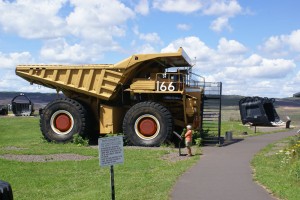
A Caterpillar 170 ton mine hauler with 10.5 ft diameter tires. They also make a 240 ton with 13 ft diameter tires. I don’t feel as bad now about replacing the 315/80R22.5 Michelins on our rig.
The Hull Rust Mohoning Mine Visitor Center is just a mile up the same little road that leads to the bus museum so we drove up there. To get to the visitor center we drove through a city park that had nice shaded RV electrical hookups. It was empty except for one tent. We saw the same thing Wednesday evening in Buffalo, North Dakota; a nice little city park with nine RV sites with electrical power, and it was empty. These parks seem to run $15/night, cheaper by the week or month. Not that we would want to stay that long, but the price is right for what you get, especially if there are things you want to do in the area. The challenge is finding these facilities.
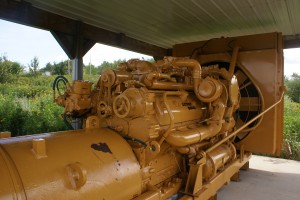
The 2,200 HP 16 cylinder Cat engine that moves the mine hauler.
The wheels on the mine haulers are driven by electric motors. The Caterpillar power module consists of a 2,200 HP 16 cylinder turbo-charged diesel engine that drives an electric alternator (the large cylinder lower left in photo) and a radiator and cooling tank. The power module with radiator, as shown, weights 28,000 pounds. In operation it burns 28 gallons of diesel fuel per hour. The hauler can reach a top speed of 30 MPH while carrying 170 or 240 tons of mined material. I think the 6 MPG we get from out bus is pretty good!

A small portion of a big hole in the ground, currently about 600 feet deep.
We spent about 45 minutes at the mine looking at the equipment displays and the big hole in the ground. Our GPS says it’s a huge lake, and at one time it had water to a depth of 325 feet, but it is still an active mine and they pumped most of the water out so they could work. Part of the original town of Hibbing had to be moved because of this mine, and it was the split into two pieces that led to the formation of the business(es) that became Greyhound Bus Lines and successor companies.
Hibbing is also the home town of Bob Dylan so Linda pulled up some information about his childhood home on her smartphone. It was supposed to be at 7th Avenue E (Bob Dylan Avenue) and 21st St., but we could not locate the house. On the drive up and back we passed through Grand Rapids (Minnesota, of course) and discovered that it was the birthplace of Judy Garland. Everybody is from somewhere.
An interesting note about Hibbing and the mine; if you look at the Minnesota state highway map and peruse the area around Hibbing, you will see brown lines that demarcate the boundaries of the three watersheds that are found in Minnesota, namely: the Mississippi River, the Atlantic (via Great Lakes / St. Lawrence Seaway), and the Hudson (Bay). About two miles NNW of the mine visitor center and viewing area is the point, unique in North America, where these three watershed boundaries meet. Depending on exactly where a raindrop falls, it will end up in one of three very different places (assuming it doesn’t evaporate and soak into the ground).
[18 L We were parked next to this aspen grove while at Forestedge Winery, a most appropriate name for the place.]

We were parked next to this aspen grove while at Forestedge Winery, a most appropriate name for the place.
We got back to Forestedge Winery before they closed and sampled some of their Plum wine, which we had somehow missed yesterday. Sharon had left for Iowa for her mother’s 93rd birthday so we invited Paul to dine with us and he accepted. Linda made a nice salad and a Farro dish with sun-dried tomatoes, kale, onion, garlic, and Italian seasonings. Paul brought a bottle of Headwaters Red wine, his rhubarb and chokecherry blend. The meal was yummy, the wine was just right, and the conversation went on for quite a while. This is one of the reasons we retired and decided to hit the road. It isn’t just about spectacular scenery and historically interesting places; it’s about encounters with spectacular and interesting people. Thank you, Paul and Sharon, for your hospitality.
